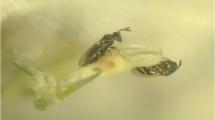Abstract
FemaleDiabrotica virgifera virgifera LeConte were allowed to choose between oviposition substrates that were and those that were not associated with potential sources of semiochemicals. Females deposited over five times more eggs on moist towelettes that were treated with homogenates of female abdomens than on towelettes treated with distilled water. Similar results were obtained when screening separated the homogenates from the towelettes, indicating that odors alone could elicit the response. In contrast, females did not choose towelettes that had previously been used for oviposition or towelettes containing eggs over unused towelettes. Further tests with homogenates of abdomens and a bacteriostatic agent (sorbate) indicated that the females were probably responding to bacterial odors rather than an oviposition-enhancing pheromone. Four strains of bacteria were isolated from a homogenate of female abdomens; females deposited 4 to 16 times more eggs on substrates with odors of the bacteria than on substrates with odors of uninoculated nutrient agar. In no-choice tests, bacterial odors did not increase the number of eggs deposited per female beetle; however, in choice tests with dishes that tended to retain any beetles that entered, there were more eggs per female (but not more beetles) after 24 hr in dishes with bacterial odors than in those without the odors. Females also chose dishes with odors of excised maize (Zea mays L.) roots or elevated levels of carbon dioxide over “control” dishes.
Similar content being viewed by others
References
Andersen, J.F., andMetcalf, R.L. 1986. Identification of a volatile attractant forDiabrotica andAcalymma spp. from blossoms ofCucurbita maxima Duchesne.J. Chem. Ecol. 12:687–699.
Benzon, G.L., andApperson, C.S. 1988. Reexamination of chemically mediated oviposition behavior inAedes aegypti (L.) (Diptera: Culicidae).J. Med. Entomol. 25:158–164.
Branson, T.F., andOrtman, E.E. 1970. The host range of larvae of the western corn rootworm: further studies.J. Econ. Entomol. 63:800–803.
Branson, T.F., andJackson, J.J. 1988. An improved diet for adultDiabrotica virgifera virgifera (Coleoptera: Chrysomelidae).J. Kans. Entomol. Soc. 61:353–355.
Branson, T.F., andKrysan, J.F. 1981. Feeding and oviposition behavior and life cycle strategies ofDiabrotica: an evolutionary view with implications for pest management.Environ. Entomol. 10:826–831.
Branson, T.F.,Guss, P.L.,Krysan, J.L., andSutter, G.R. 1975. Corn rootworms: Laboratory rearing and manipulation. ARS-NC-28.
Branson, T.F., Jackson, J.J., andSutter, G.R. 1988. Improved method for rearingDiabrotica virgifera virgifera (Coleoptera: Chrysomelidae).J. Econ. Entomol. 81:410–414.
Drew, R.A.I., andLloyd, A.C. 1987. Relationship of frait flies (Diptera: Tephritidae) and their bacteria to host plants.Ann. Entomol. Soc. Am. 80:629–636.
Eddy, G.W., Devaney, J.A., andHandke, B.D. 1975. Response of the adult screwworm (Diptera: Calliphoridae) to bacteria inoculated and incubated bovine blood in olfactometer and oviposition tests.J. Med. Entomol. 12:379–381.
Guss, P.L., Sonnet, P.E., Carney, R.L., Branson, T.F., andTumlinson, J.H. 1984. Response ofDiabrotica virgifera virgifera, D. v.zeae, andD. porracea to stereoisomers of 8-methyl-2-decyl propanoate.J. Chem. Ecol. 10:1123–1131.
Hibbard, B.E., andBjostad, L.B. 1990. Isolation of corn semiochemicals attractive and repellent to western corn rootworm larvaeJ. Chem. Ecol. 16:3425–3439.
Hough, J.A., Eckenrode, C.J., andHarman, G.E. 1982. Nonpathogenic bacteria affecting oviposition behavior in the onion fly.Environ. Entomol. 11:585–589.
Hough-Goldstein, J.A., andBassler, M.A. 1988. Effects of bacteria on oviposition by seedcorn maggots (Diptera: Anthomyiidae).Environ. Entomol. 17:7–12.
Lampman, R.L., andMetcalf, R.L. 1987. Multicomponent kairomonal lures for southern and western corn rootworms (Coleoptera: Chrysomelidae:Diabrotica spp.).J. Econ. Entomol. 80:1137–1142.
Lampman, R.L., Metcalf, R.L., andAndersen, J.F. 1987. Semiochemical attractants ofDiabrotica undecimpunctata howardi Barber, southern corn rootworm, andDiabrotica virgifera virgifera, the western corn rootworm (Coleoptera: Chrysomelidae).J. Chem. Ecol. 13:959–975.
Metcalf, R.L., andLampman, R.L. 1989. Estragole analogues as attractants for corn rootworms (Coleoptera: Chrysomelidae).J. Econ. Entomol. 82:123–129.
Metcalf, R.L., Metcalf, R.A., andRhodes, A.M. 1980. Cucurbitacins as kairomones for diabroticite beetles.Proc. Natl. Acad. Sci. USA 77:3769–3772.
Prystupa, B., Ellis, C.R., andTeal, P.E.A. 1988. Attraction of adultDiabrotica (Coleoptera: Chrysomelidae) to corn silks and analysis of the host-finding response.J. Chem. Ecol. 14:635–651.
Schalk, J.M., Peterson, J.K., andHamalle, R.J. 1987. The abdominal flora of the banded cucumber beetle (Diabrotica balteata LeConte).J. Agr. Entomol. 4:333–336.
Strnad, S.P., Bergman, M.K., andFulton, W.C. 1986. First-instar western corn rootworm (Coleoptera: Chrysomelidae) response to carbon dioxide.Environ. Entomol. 15:839–842.
Tran, M.T., andMarrone, P.G. 1988. Bacteria isolated from southern corn rootworms,Diabrotica undecimpunctata howardi (Coleoptera: Chrysomelidae), reared on artificial diet and corn.Environ. Entomol. 17:832–835.
Wilkinson, L. 1990. SYSTAT: The System for Statistics. SYSTAT, Inc., Evanston, IL.
Author information
Authors and Affiliations
Additional information
Mention of a commercial or proprietary product does not constitute an endorsement for its use by USDA.
Rights and permissions
About this article
Cite this article
Lance, D.R. Odors influence choice of oviposition sites byDiabrotica virgifera virgifera (Coleoptera: Chrysomelidae). J Chem Ecol 18, 1227–1237 (1992). https://doi.org/10.1007/BF00980076
Received:
Accepted:
Issue Date:
DOI: https://doi.org/10.1007/BF00980076




